2018-08-30 - Nº 174
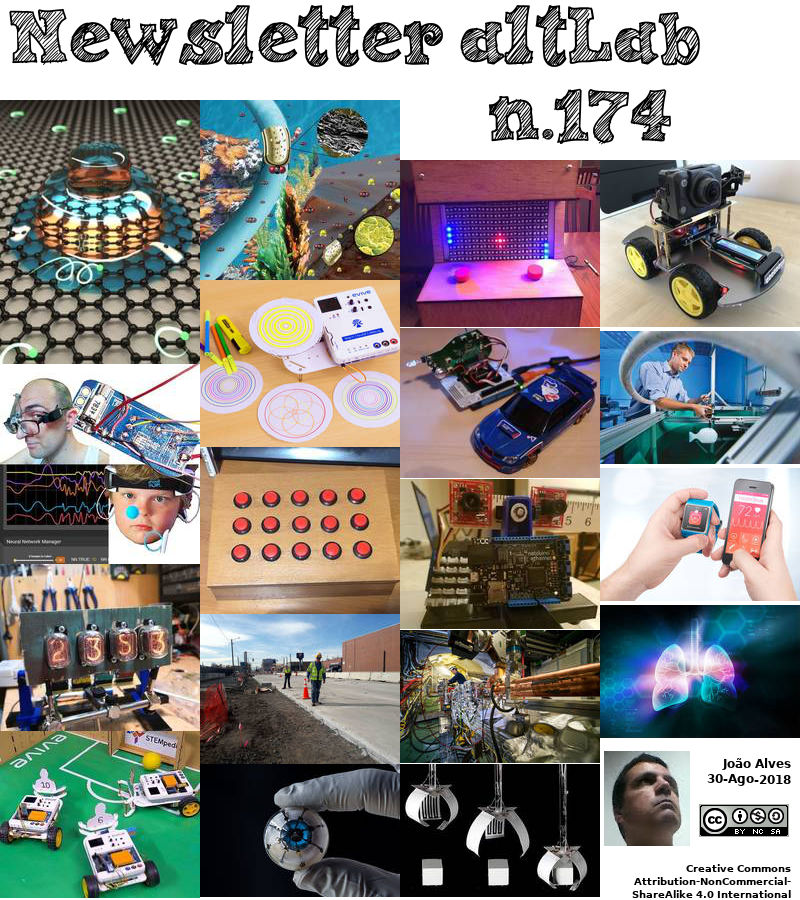
Editorial
Esta é a Newsletter Nº 174 que se apresenta com o mesmo formato que as anteriores. Se gostar da Newsletter partilhe-a!
Todas as Newsletters encontram-se indexadas no link.
Esta Newsletter tem os seguintes tópicos:
Faz hoje anos que nascia, em 1852, Jacobus Henricus Van't Hoff. Este Químico e físico holandês foi o primeiro vencedor do Prémio Nobel de Química (1901) "em reconhecimento pelos serviços extraordinários que ele prestou pela descoberta das leis da dinâmica química e pressão osmótica em soluções." Na estéreo-química, em 1874, ele identificou as quatro ligações químicas do carbono como tendo um arranjo tetraédrico, que explicou como certas moléculas podem ser arranjadas diferentemente com os mesmos átomos para dar isómero à esquerda e à direita. (Achille Bel chegou independentemente na mesma conclusão mais ou menos na mesma época.) Com relação à pressão osmótica de líquidos, ele derivou leis (1886) para soluções diluídas semelhantes às leis de gases de Robert Boyle e Joseph Gay-Lussac. Estas relações permitiram a determinação experimental do peso molecular de uma substância em solução.
Faz também anos hoje que nascia, em 1863, Sergey Prokudin-Gorsky. Este químico e fotógrafo russo ficou conhecido pelo seu trabalho pioneiro em fotografia colorida e seu esforço para documentar a Rússia do início do século XX. Usando uma câmara escura fornecida pelo czar Nicolau II, Prokudin-Gorsky viajou pelo Império Russo de 1909 a 1915 usando sua fotografia colorida de três imagens para registar muitos dos seus aspectos. Enquanto alguns de seus negativos foram perdidos, a maioria acabou na Biblioteca do Congresso dos EUA após sua morte. A partir de 2000, os negativos foram digitalizados e a cor triplica para cada assunto digitalmente combinada para produzir centenas de imagens coloridas de alta qualidade da Rússia do século passado.
Faz igualmente anos hoje que nascia, em 1871, Ernest Rutherford. Este físico neozelandês-inglês lançou as bases para o desenvolvimento da física nuclear. Ele colaborou com Frederick Soddy no estudo da radioactividade. Em Setembro de 1898, ele datou um artigo nomeando partículas alfa e partículas beta (a radiação gama foi descoberta em 1900 por Paul Villard) no ano seguinte. Em 1905, com Soddy, ele anunciou que o decaimento radioactivo envolve uma série de transformações. Em 1907, com Hans Geiger e Ernest Marsden, ele desenvolveu a experiência de espalhar partículas alfa que levou, em 1911, à descoberta do núcleo atómico. Em 1919 ele conseguiu a divisão artificial de átomos leves. Em 1908 ele foi premiado com o Prémio Nobel de Química.
Faz também anos hoje que nascia, em 1884, Theodor Svedberg. Este químico sueco ganhou o Prémio Nobel de Química de 1926 pelo seu estudo da química de colóides e sua invenção de uma ultra-centrífuga (1923) como uma técnica para investigar os pesos moleculares de moléculas muito grandes. Ele mostrou que os pesos moleculares das proteínas eram muito maiores do que se pensava originalmente (a hemoglobina, por exemplo, tem um peso molecular de cerca de 68.000). Já que as medições de peso repetidamente deram os mesmos valores, o que implica que as partículas tinham um tamanho e composição definidos, Svedberg assim refutou o modelo de Wilhelm Ostwald de conjuntos irregulares de moléculas menores. Svedberg também contribuiu para o desenvolvimento do ciclotron e do processo de eletroforese da análise química.
Faz igualmente anos hoje que nascia, em 1907, John Mauchly. Este engenheiro e físico norte-americano, com John P. Eckert inventou (1946) o Electronic Numerical Integrator and Computer (ENIAC), o primeiro computador electrónico de utilização genérica. Mauchly inicialmente concebeu a arquitectura do computador e Eckert possuía as habilidades de engenharia para dar vida à ideia. O ENIAC foi desenvolvido para o Departamento de Artilharia do Exército dos EUA como o que provavelmente foi o primeiro computador electrónico de utilização genérica. Era uma máquina vasta, consumia 100 kW de energia eléctrica e continha 18.000 válvulas electrónicas. O seu bem-sucedido computador UNIVAC lançado em 1951 foi o primeiro computador comercial e introduziu fita magnética para programação.
Por fim, faz anos hoje que nascia, em 1912, Edward Mills Purcell. Este físico norte-americano dividiu o Prémio Nobel de Física de 1952 com Felix Bloch pelo desenvolvimento independente da ressonância magnética nuclear (RMN) em líquidos e sólidos. A RMN tornou-se uma poderosa ferramenta amplamente utilizada para estudar a estrutura molecular de materiais puros e a composição de misturas. O método detecta e mede os campos magnéticos dos núcleos atómicos.
Esta semana ficámos a saber que um sistema de condução autónoma esta a ser testado em Táxis no Japão. Um táxi autónomo conseguiu levar os passageiros pelas movimentadas ruas de Tóquio, aumentando a perspectiva de que o serviço esteja pronto a tempo de transportar atletas e turistas entre os locais desportivos e o centro da cidade durante os Jogos Olímpicos de Verão de 2020. A ZMP, empresa que desenvolve a tecnologia de condução autónoma, e a empresa de táxis Hinomaru Kotsu, afirmam que os testes de estrada, que começaram esta semana, são os primeiros do mundo a envolver taxistas sem motorista e passageiros com tarifas pagas.
Também esta semana ficámos a saber que a Tesla planeia abrir seu software de segurança de veículos gratuitamente para outras empresas para um futuro mais seguro e autónomo. Com o aumento esperado de veículos autónomos e mais conectados, surge um risco maior de hackear esses veículos com intenções destrutivas. Elon Musk acha que o software de segurança da Tesla é a melhor solução e ele planeia abrir o código gratuitamente para outras empresas para um futuro mais seguro.
Na Newsletter desta semana apresentamos diversos projetos de maker. É apresentada a revista MagPI nº73 de Setembro.
 João Alves ([email protected])
João Alves ([email protected])
O conteúdo da Newsletter encontra-se sob a licença  Creative Commons Attribution-NonCommercial-ShareAlike 4.0 International License.
Creative Commons Attribution-NonCommercial-ShareAlike 4.0 International License.
Novidades da Semana

Driverless taxi debuts in Tokyo in 'world first' trial ahead of Olympics
"A self-driving taxi has successfully taken paying passengers through the busy streets of Tokyo, raising the prospect that the service will be ready in time to ferry athletes and tourists between sports venues and the city centre during the 2020 Summer Olympics. ZMP, a developer of autonomous driving technology, and the taxi company Hinomaru Kotsu, claim that the road tests, which began this week, are the first in the world to involve driverless taxis and fare-paying passengers. The trial took place as Toyota and the transport giant Uber said they were intensifying efforts to develop a self-driving vehicle, pitting themselves against rival initiatives in Japan, the US and Europe. Toyota will invest $500m in the venture, which will develop vehicles based on the carmakers’ Sienna minivans, with a view to start testing in 2021, the firms said this week. Uber's autonomous driving venture suffered a setback in March when one of its self-driving vans struck and killed a pedestrian during a trial in Arizona. Nissan and the tech firm DeNa tested their Easy Ride robo-vehicle service along a 4.5km set route in the port city of Yokohama earlier this year." [...]
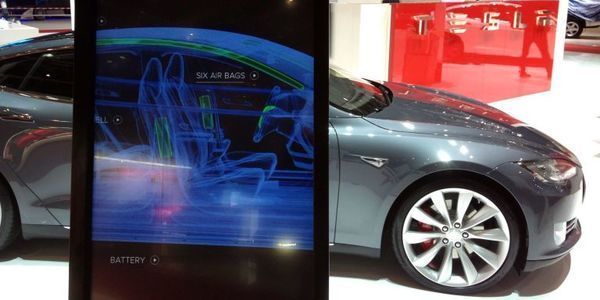
Tesla plans to open-source its vehicle security software for free to other automakers for safer self-driving future
"With the upcoming rise of self-driving and more connected vehicles come an increased risk of hacking those vehicles with ill-intent. Elon Musk thinks that Tesla’s vehicle security software is the best solution and he plans to open-source it for free to other automakers for a safer self-driving future. Musk has expressed concerns about hackers gaining access to Tesla system in the past. He said that preventing a ‘fleet-wide hack’ is Tesla’s top security priority. At the National Governors Association last year, Musk gave some more interesting insights into Tesla’s security effort and especially related to once their vehicles become fully autonomous: “I think one of the biggest concern for autonomous vehicles is somebody achieving a fleet-wide hack.” He followed with an interesting example of what someone could do with that kind of access: “In principles, if someone was able to say hack all the autonomous Teslas, they could say – I mean just as a prank – they could say ‘send them all to Rhode Island’ [laugh] – across the United States… and that would be the end of Tesla and there would be a lot of angry people in Rhode Island.” The CEO said that Tesla developed “specialized encryption” for “multiple sub-systems” in the vehicle and they are developing something for drivers to always have “override authority” if your autonomous vehicle starts doing something “wacky.”" [...]
Outras Notícias

Announcing the Arduino Command Line Interface (CLI)
"The Arduino team has been working hard to support the needs of our professional developer community. Many of you requested a way to use our tools in Makefiles, and wanted Arduino IDE features available via a fast, clean command line interface. How cool would it be to install project dependencies with: arduino-cli lib install "WiFi101” “WiFi101OTA” So that’s what we’ve done! To make it even cooler, most Arduino CLI commands have the option to output JSON for easy parsing by other programs: arduino-cli --format json lib search wifinina | jq { "libraries": [ { "Name": "WiFiNINA", "Author": "Arduino", "Maintainer": "Arduino info@arduino.cc", "Sentence": "Enables network connection (local and Internet) with the Arduino MKR WiFi 1010, Arduino MKR VIDOR 4000 and Arduino UNO WiFi Rev.2. ", "Paragraph": "With this library you can instantiate Servers, Clients and send/receive UDP packets through WiFi. The board can connect either to open or encrypted networks (WEP, WPA)." [...]
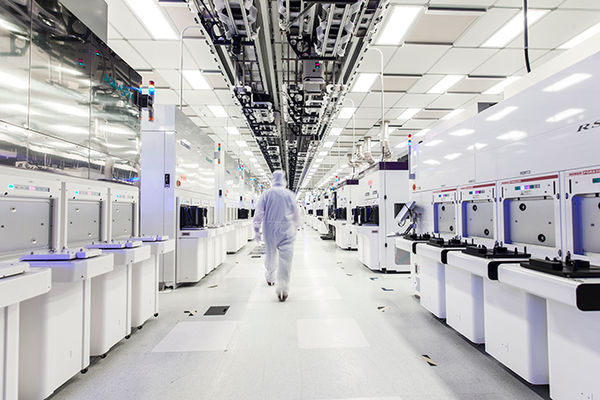
GLOBALFOUNDRIES Reshapes Technology Portfolio to Intensify Focus on Growing Demand for Differentiated Offerings
"Semiconductor manufacturer realigns leading-edge roadmap to meet client need and establishes wholly-owned subsidiary to design custom ASICs GLOBALFOUNDRIES today announced an important step in its transformation, continuing the trajectory launched with the appointment of Tom Caulfield as CEO earlier this year. In line with the strategic direction Caulfield has articulated, GF is reshaping its technology portfolio to intensify its focus on delivering truly differentiated offerings for clients in high-growth markets. GF is realigning its leading-edge FinFET roadmap to serve the next wave of clients that will adopt the technology in the coming years. The company will shift development resources to make its 14/12nm FinFET platform more relevant to these clients, delivering a range of innovative IP and features including RF, embedded memory, low power and more. To support this transition, GF is putting its 7nm FinFET program on hold indefinitely and restructuring its research and development teams to support its enhanced portfolio initiatives. This will require a workforce reduction, however a significant number of top technologists will be redeployed on 14/12nm FinFET derivatives and other differentiated offerings." [...]

Colorado Prepares to Install "Smart Road" Product by Integrated Roadways
"A basket of sensors buried in the pavement will measure the speed, weight, and trajectory of vehicles that pass over it On 30 August, a startup plans to add its “smart pavement” to an intersection in an industrial corner of Denver. The company has encased assorted electronics within four slabs of concrete and will wedge those slabs into the road between a Pepsi Co. bottling plant and two parking lots. Integrated Roadways says its product, which can deduce the speed, weight, and direction of a vehicle from the basket of sensors buried in the pavement, will face its first real-world test at that discreet Denver junction. The company can then use that data to alert authorities to accidents or prompt officials to reconfigure lanes to relieve congestion. It’s one approach to so-called “smart roads,” which aim to combine sensing and intelligence in ways that reduce the hazards and hassles of vehicular travel. If all goes well in that first test, Integrated Roadways will replace 500 meters of pavement along a dangerous curve in Highway 285, just south of Denver, with its product in early 2019." [...]

AWAKE successfully accelerates electrons
"Early in the morning on Saturday, 26 May 2018, the AWAKE collaboration at CERN successfully accelerated electrons for the first time using a wakefield generated by protons zipping through a plasma. A paper describing this important result was published in the journal Nature today. The electrons were accelerated by a factor of around 100 over a length of 10 metres: they were externally injected into AWAKE at an energy of around 19 MeV (million electronvolts) and attained an energy of almost 2 GeV (billion electronvolts). Although still at a very early stage of development, the use of plasma wakefields could drastically reduce the sizes, and therefore the costs, of the accelerators needed to achieve the high-energy collisions that physicists use to probe the fundamental laws of nature. The first demonstration of electron acceleration in AWAKE comes only five years after CERN approved the project in 2013 and is an important first step towards realising this vision. AWAKE, which stands for “Advanced WAKEfield Experiment”, is a proof-of-principle R&D project investigating the use of protons to drive plasma wakefields for accelerating electrons to higher energies than can be achieved using conventional technologies." [...]

Mbed OS 5.9.6 released
"We are pleased to announce the Mbed OS 5.9.6 release is now available. This is the latest patch release based on the feature set that Mbed OS 5.9 introduces. Summary The CMake exporter is now capable of creating combined hex files for targets. The low power ticker has been updated to prevent unnecessary rescheduling. Fast Models' memory regions have been updated to make maintenance simpler as well as use an extra region of SRAM that was previously unutilized. Additionally, the change prepares the targets for other changes that will be showing up in the near future." [...]

Allegro MicroSystems Releases a Fully Integrated, Monolithic Power Monitoring IC with Reinforced Isolation
"Allegro MicroSystems has released a fully integrated, small form factor, power monitoring IC with reinforced voltage isolation. Allegro’s ACS724 and ACS711 current sensor ICs are commonly used in internet connected power outlets and other IOT devices. The ACS71020 improves upon these popular ICs by including power sensing functions and by eliminating power and isolation components that would otherwise increase the cost and the size of customer systems. The ACS71020 IC builds upon our innovative Hall-effect current sensor IC technology by adding line voltage sensing (to voltage levels > 500 VRMS) and a dedicated metrology engine that digitally calculates detected power levels. This enables the first power monitor IC that can be powered from the same voltage supply as the system microprocessor, without needing digital isolators or multiple power supplies. Allegro’s new power monitor IC simplifies common power measurements by offering digital computation of parameters including active, reactive and apparent power." [...]
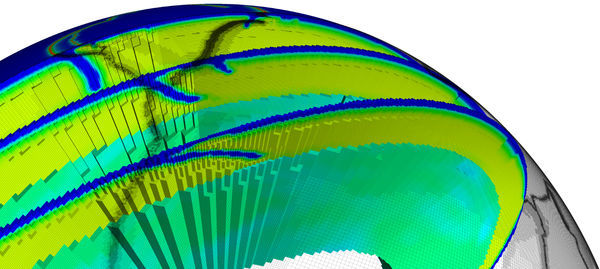
New Supercomputer at Texas Advanced Computing Center Powered by Next-Gen Intel Xeon Scalable Processors
"The Texas Advanced Computing Center (TACC) at The University of Texas at Austin announced its latest supercomputer, known as Frontera, will be powered by next-generation Intel® Xeon® Scalable processors. Academic researchers hope the new supercomputer will enable important discoveries across scientific fields, from astrophysics to zoology. “Accelerating scientific discovery lies at the foundation of the TACC’s mission, and enabling technologies to advance these discoveries and innovations is a key focus for Intel,” said Patricia Damkroger, vice president and general manager, Extreme Computing Group at Intel. frontera black 01Frontera is expected to enter production in the summer of 2019. It is the latest in a string of successful supercomputers from TACC that leverage Intel technology. Since 2006, TACC has built and operated three supercomputers that debuted among the world’s 10 most powerful systems: Ranger (2008), Stampede1 (2012) and Stampede2 (2017)." [...]

Martian Skies Clearing over Opportunity Rover
"A planet-encircling dust storm on Mars, which was first detected May 30 and halted operations for the Opportunity rover, continues to abate. With clearing skies over Opportunity's resting spot in Mars' Perseverance Valley, engineers at NASA's Jet Propulsion Laboratory in Pasadena, California, believe the nearly 15-year-old, solar-powered rover will soon receive enough sunlight to automatically initiate recovery procedures -- if the rover is able to do so. To prepare, the Opportunity mission team has developed a two-step plan to provide the highest probability of successfully communicating with the rover and bringing it back online. "The Sun is breaking through the haze over Perseverance Valley, and soon there will be enough sunlight present that Opportunity should be able to recharge its batteries," said John Callas, Opportunity project manager at JPL. "When the tau level [a measure of the amount of particulate matter in the Martian sky] dips below 1.5, we will begin a period of actively attempting to communicate with the rover by sending it commands via the antennas of NASA's Deep Space Network. Assuming that we hear back from Opportunity, we will begin the process of discerning its status and bringing it back online."" [...]
Ciência e Tecnologia
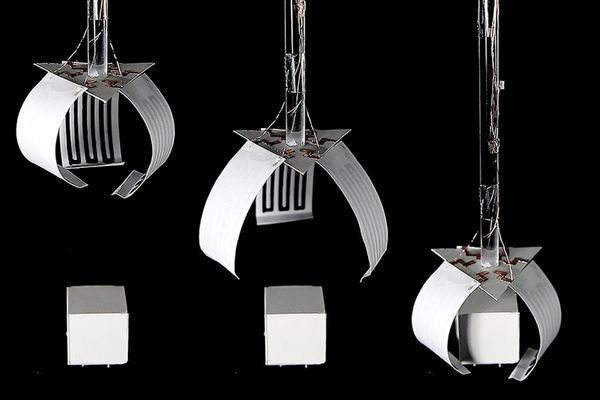
Actuation Gives New Dimensions to an Old Material
"One of the oldest, most versatile and inexpensive of materials — paper — seemingly springs to life, bending, folding or flattening itself, by means of a low-cost actuation technology developed at Carnegie Mellon University's Human-Computer Interaction Institute. A thin layer of conducting thermoplastic, applied to common paper with an inexpensive 3D printer or even painted by hand, serves as a low-cost, reversible actuator. When an electrical current is applied, the thermoplastic heats and expands, causing the paper to bend or fold; when the current is removed, the paper returns to a pre-determined shape. "We are reinventing this really old material," said Lining Yao, assistant professor in the HCII and director of the Morphing Matter Lab, who developed the method with her team. "Actuation truly turns paper into another medium, one that has both artistic and practical uses." Post-doctoral researcher Guanyun Wang, former research intern Tingyu Cheng and other members of Yao's Morphing Matter Lab have designed basic types of actuators, including some based on origami and kirigami forms." [...]
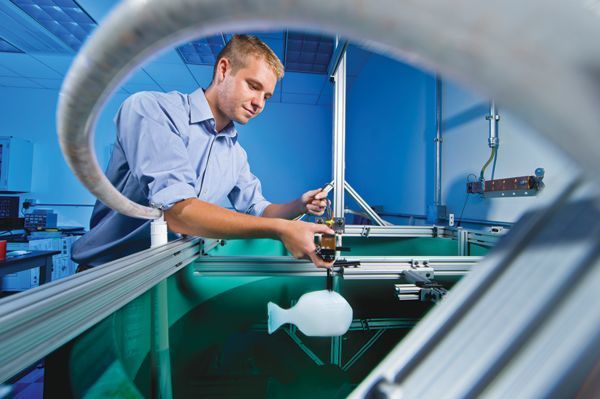
Inspired by Nature: Autonomous Underwater Robotics
"Since he was a child, Derek Paley has been captivated by how shoals of fish move fluidly as a cohesive group, almost as if a single organism. As the Willis H. Young Jr. Professor of Aerospace Engineering Education and director of the Collective Dynamics and Control Laboratory at the University of Maryland, Paley is applying his long-standing source of inspiration to the cooperative control of autonomous vehicles. Fish are particularly interesting for Paley because of their sensory system. He explains that fish have a lateral line system, which is a series of sensors located on their exterior, sometimes appearing on their side as a stripe. With their lateral line sense, fish can perceive the direction and speed of nearby water flow, as well as predators and other obstacles." [...]

Computing Catalysts
"Polyisobutylene (PIB) is a workhorse polymer that is found in a multitude of products, ranging from chewing gum, to tires, to engine oil and gasoline additives. Although commercially produced in large quantities since the 1940s, PIB chemistry was a mystery – scientists weren’t sure how the reaction mechanism that creates the polymer happens at the molecular level, which limited further potential. However, a collaboration between the University of Pittsburgh’s Swanson School of Engineering and Wickliffe, Ohio-based Lubrizol Corporation has unlocked the secrets of PIB’s reaction mechanism. The group’s findings were published this month in the journal ACS Catalysis (DOI: 10.1021/acscatal.8b01494). Principal investigator is Karl Johnson, the William Kepler Whiteford Professor in the Swanson School’s Department of Chemical & Petroleum Engineering. Funding for the research was provided by Lubrizol, which in 2014 established a $1.2 million strategic partnership with the Department and Swanson School to jumpstart research innovation that also offers opportunities for undergraduates to participate." [...]

Solved! Caltech Researcher Helps Crack Decades-Old Math Problem
"Spiros Michalakis, manager of outreach and staff researcher at Caltech's Institute for Quantum Information and Matter (IQIM), and Matthew Hastings, a researcher at Microsoft, have solved one of the world's most challenging open problems in the field of mathematical physics. The problem, related to the "quantum Hall effect," was first proposed in 1999 as one of 13 significant unsolved problems to be included on a list maintained by Michael Aizenman, a professor of physics and mathematics at Princeton University and the former president of the International Association of Mathematical Physics. Like the "millennium" math challenges put forth by the Clay Mathematics Institute in 2000, the idea behind these problems was to record some of the most perplexing unsolved puzzles in mathematical physics—a field that uses rigorous mathematical reasoning to address physics questions. So far, the problem undertaken by Michalakis is the only one fully solved, while another has been partially solved. Progress made on the partially-solved problem has resulted in two Fields Medals, the highest honor in mathematics. "I hope that the solution to this problem will invigorate interest in the field of mathematical physics," says Michalakis." [...]

These lithium-ion batteries can't catch fire because they harden on impact
"Lithium-ion batteries commonly used in consumer electronics are notorious for bursting into flame when damaged or improperly packaged. These incidents occasionally have grave consequences, including burns, house fires and at least one plane crash. Inspired by the weird behavior of some liquids that solidify on impact, researchers have developed a practical and inexpensive way to help prevent these fires. They will present their results today at the 256th National Meeting & Exposition of the American Chemical Society (ACS). ACS, the world’s largest scientific society, is holding the meeting here through Thursday. It features more than 10,000 presentations on a wide range of topics." [...]
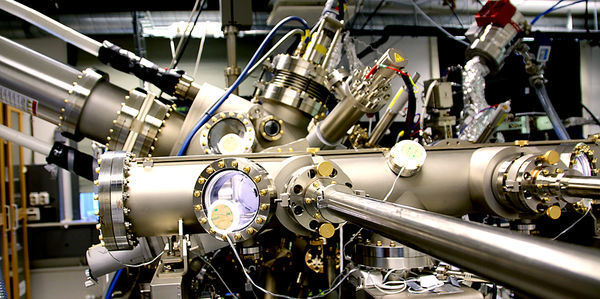
Building miniature lasers with nanowires
"Impossibly small, accurate lasers could pave the way for new medical applications and electronics. A large machine with all manner of assorted protruding pipes stands ready for action in one of the labs at NTNU’s Department of Electronic Systems. Some of the pipes are protected by insulating material, while others are wrapped in silver paper. Inside this new “MBE” machine, a research breakthrough has recently taken place. MBE stands for molecular beam epitaxy. Special superlattice Welcome to the world of nanotechnology, where quantum structures rule and constituents are so small that they’re measured in billionths of a metre: one nanometre (nm) is equal to 10e-9 meters (one billionth of a metre)." [...]
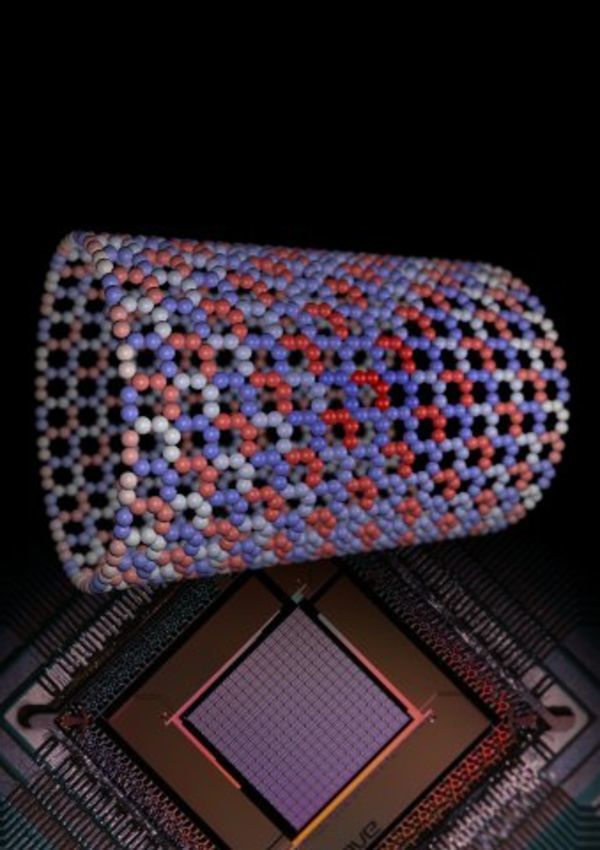
D-Wave Breakthrough Demonstrates First Large-Scale Quantum Simulation of Topological State of Matter
"D-Wave Systems Inc., the leader in quantum computing systems and software, today published a milestone study demonstrating a topological phase transition using its 2048-qubit annealing quantum computer. This complex quantum simulation of materials is a major step toward reducing the need for time-consuming and expensive physical research and development. The paper, entitled “Observation of topological phenomena in a programmable lattice of 1,800 qubits”, was published in the peer-reviewed journal Nature (Vol. 560, Issue 7719, August 22, 2018). This work marks an important advancement in the field and demonstrates again that the fully programmable D-Wave quantum computer can be used as an accurate simulator of quantum systems at a large scale. The methods used in this work could have broad implications in the development of novel materials, realizing Richard Feynman’s original vision of a quantum simulator." [...]
Researchers Turn Tracking Codes into Unclonable "Clouds" to Authenticate Genuine 3D Printed Parts
"Researchers at NYU Tandon and NYU Abu Dhabi are the First to Convert Flat QR Codes into Complex Features Hidden within 3D-Printed Parts to Foil Counterfeiters and IP Pirates The worldwide market for 3D-printed parts is a $5 billion business with a global supply chain involving the internet, email, and the cloud – creating a number of opportunities for counterfeiting and intellectual property theft. Flawed parts printed from stolen design files could produce dire results: experts predict that by 2021, 75 percent of new commercial and military aircraft will fly with 3D-printed engine, airframe, and other components, and the use of AM in the production of medical implants will grow by 20 percent per year over the next decade. A team at NYU Tandon School of Engineering has found a way to prove the provenance of a part by employing QR (Quick Response) codes in an innovative way for unique device identification. In the latest issue of Advanced Engineering Materials, the researchers describe a method for converting QR codes, bar codes, and other passive tags into three-dimensional features hidden in such a way that they neither compromise the part’s integrity nor announce themselves to counterfeiters who have the means to reverse engineer the part. Noted materials researcher Nikhil Gupta, an associate professor of mechanical engineering at NYU Tandon; Fei Chen, a doctoral student under Gupta; and joint NYU Tandon and NYU Abu Dhabi researchers Nektarios Tsoutsos, Michail Maniatakos and Khaled Shahin, detail how they exploited the layer-by-layer AM printing process to turn QR codes into a game of 3D chess. Gupta’s team developed a scheme that “explodes” a QR code within a computer-assisted design (CAD) file so that it presents several false faces — dummy QR tags — to a micro-CT scanner or other scanning device." [...]
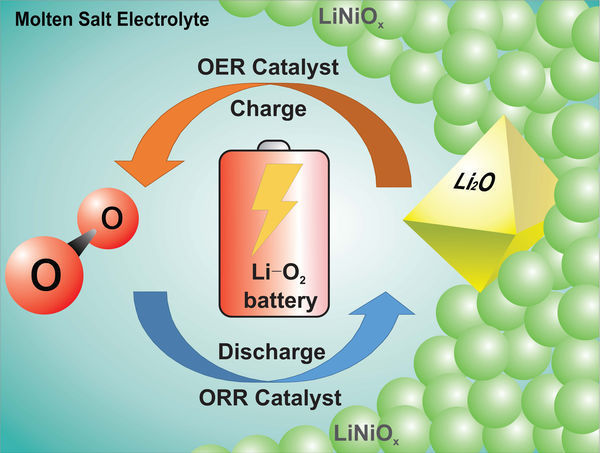
Chemists make breakthrough on road to creating a rechargeable lithium-oxygen battery
"Chemists from the University of Waterloo have successfully resolved two of the most challenging issues surrounding lithium-oxygen batteries, and in the process created a working battery with near 100 per cent coulombic efficiency. The new work, which appears this week in Science, proves that four-electron conversion for lithium-oxygen electrochemistry is highly reversible. The team is the first to achieve four-electron conversion, which doubles the electron storage of lithium-oxygen, also known as lithium-air, batteries. “There are limitations based on thermodynamics,” said Linda Nazar, Canada Research Chair in Solid State Energy Materials and senior author on the project. “Nevertheless, our work has addressed fundamental issues that people have been trying to resolve for a long time.” The high theoretical-energy density of lithium-oxygen (Li-O2) batteries and their relatively light weight have made them the Holy Grail of rechargeable battery systems. But long-standing issues with the battery’s chemistry and stability have kept them a purely academic curiosity." [...]

Rice U. lab finds evidence of matter-matter coupling
"Physicists show first proof of Dicke cooperativity in a matter-matter system After their recent pioneering experiments to couple light and matter to an extreme degree, Rice University scientists decided to look for a similar effect in matter alone. They didn’t expect to find it so soon. Rice physicist Junichiro Kono, graduate student Xinwei Li and their international colleagues have discovered the first example of Dicke cooperativity in a matter-matter system, a result reported in Science this week. The discovery could help advance the understanding of spintronics and quantum magnetism, Kono said. On the spintronics side, he said the work will lead to faster information processing with lower power consumption and will contribute to the development of spin-based quantum computing. The team’s findings on quantum magnetism will lead to a deeper understanding of the phases of matter induced by many-body interactions at the atomic scale." [...]

Graphene laminated pipes could reduce corrosion in the oil and gas industry
"Researchers at The University of Manchester and TWI have discovered ways of using graphene to prolong the lifetime of pipes used in the oil and gas industry. Published in Advanced Materials Interfaces, the team have found a way of incorporating graphene into a polymer liner used in pipes that transport crude oil and gas from the sea floor. The pipes are generally made of internal layers of polymer or composite and external strengthening steel. Within these pipes, fluids may be at very high pressure and elevated temperature. In situations where carbon dioxide (CO2), hydrogen sulfide (H2S) and water permeate through the protective barrier layer of the pipe, the steel may corrode causing the pipe to lose strength over time, leading to a risk of catastrophic failure. The researchers found that if the graphene was mechanically mixed with the plastic, or if a single layer of graphene were applied, gases were still able to pass through." [...]
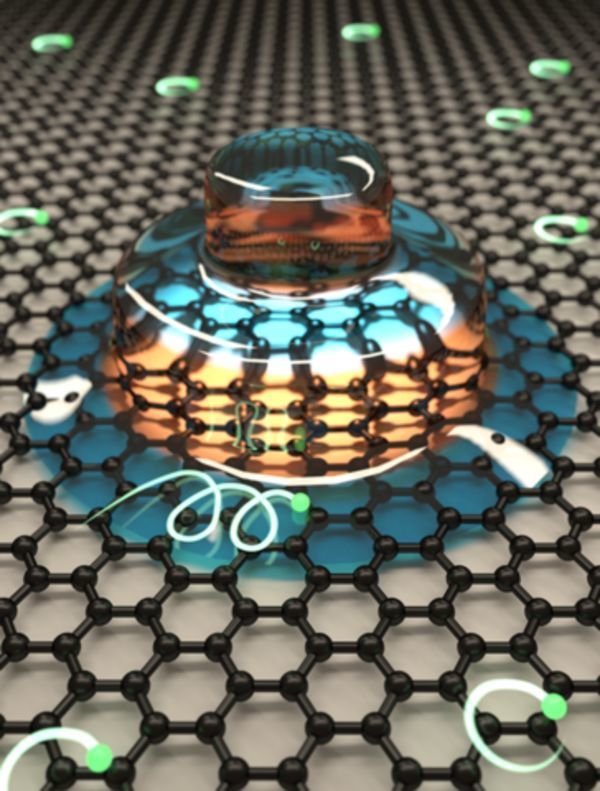
A Novel Graphene Quantum Dot Structure Takes the Cake
"In a marriage of quantum science and solid-state physics, researchers at the National Institute of Standards and Technology (NIST) have used magnetic fields to confine groups of electrons to a series of concentric rings within graphene, a single layer of tightly packed carbon atoms. This tiered “wedding cake,” which appears in images that show the energy level structure of the electrons, experimentally confirms how electrons interact in a tightly confined space according to long-untested rules of quantum mechanics. The findings could also have practical applications in quantum computing. Graphene is a highly promising material for new electronic devices because of its mechanical strength, its excellent ability to conduct electricity and its ultrathin, essentially two-dimensional structure. For these reasons, scientists welcome any new insights on this wonder material. The researchers, who report their findings in the Aug. 24 issue of Science, began their experiment by creating quantum dots—tiny islands that act as artificial atoms—in graphene devices cooled to just a few degrees above absolute zero." [...]
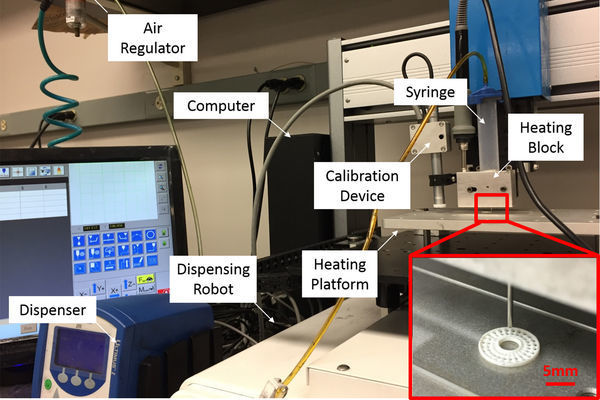
First-ever 3D-printed electrolyte for lithium-ion batteries
"For the first time, researchers have successfully printed a complete, albeit experimental, lithium-ion battery including a solid-state electrolyte. While electrodes have been produced using 3D-printing technology before, researchers at the University of Illinois at Chicago College of Engineering have printed a stable, yet flexible, solid-state electrolyte using an elevated-temperature extrusion printing technique. They report their findings in the journal Advanced Materials. Lithium-ion batteries are commonly used in home and portable electronics, and in some motor vehicles. They function by the movement of lithium ions from the negative electrode through an electrolyte, which can be liquid or solid, to the positive electrode during discharge and then back during the charge phase. Mass producing these batteries is a laborious and expensive process." [...]
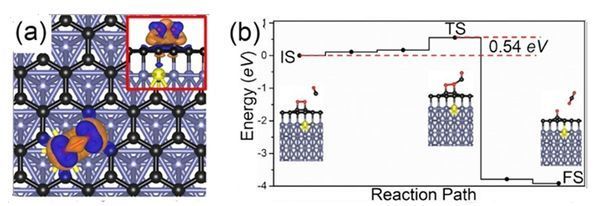
High performance graphene-based catalysts
"NUS scientists have developed design guidelines that increase the catalytic effectiveness of graphene-based solid state catalysts for potential industry applications. Catalysts are widely used in the chemical industry to make manufacturing processes more efficient and economical. This is achieved by providing an alternative pathway for the synthesis of chemicals and compounds. Graphene-based solid state catalysis (GBSSC) is an emerging research direction, which opens new opportunities for graphene applications in the production of chemicals. Graphene has a very high surface-to-volume ratio and is therefore expected to be a promising candidate for catalysts. However, as graphene itself is chemically inert, an effective yet practical way is required to activate and unlock its catalytic potential." [...]
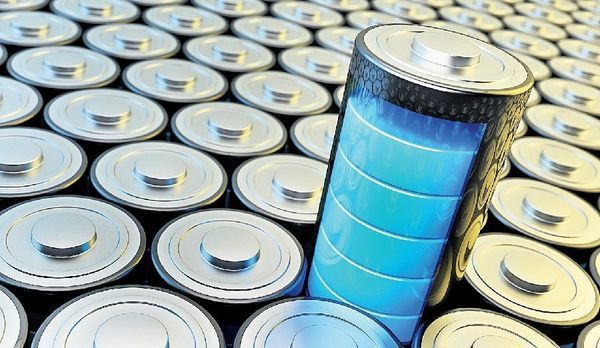
The Peaceful Atom in Smartphone: Scientists Learn How to "Predict" Properties of Nuclear Batteries
"A group of Russian researchers from NUST MISIS, the Institute of Microelectronics Technology & High-Purity Materials RAS, and the National Research Center “Kurchatov Institute”, has proposed a method of accurately predicting the properties of beta-voltaic batteries. Its application will significantly reduce the cost of developing these elements. Scientists and researchers from around the world have been trying to solve the problem of high-efficiency beta-voltaic elements (nuclear batteries) for more than half a century. The pursuit is based on the conversion of beta-radiation of the radioactive nickel isotope into electrical energy with the help of a conductor. These high-efficiency batteries can last for decades and have a wide range of potential applications, from medicine to space technology. The inability to accurately predict the operating parameters of batteries has forced experts to operate on a trial and error system for decades, and is a serious limitation for many developers." [...]

Organizing Quantum Dots May Improve Consumer Electronics
"Carnegie Mellon University Materials Science and Engineering Professor Michael Bockstaller and his team are working on ways for quantum dots, or nanoparticles created from a specific semiconductor, to self-assemble into organized patterns. The research may help improve the quality of image displays for electronic devices like televisions. He and colleagues at the University of Houston recently received a Department of Energy Basic Energy Sciences three-year, $1.1 million grant to advance the work. When the dots are surrounded by particles of the same color, it minimizes heat absorption and increases efficiency. The team has already proved that they are able to control these nanoparticles by attaching a polymer chain to them. Now, they plan to study exactly what about the polymer causes the particles to move." [...]
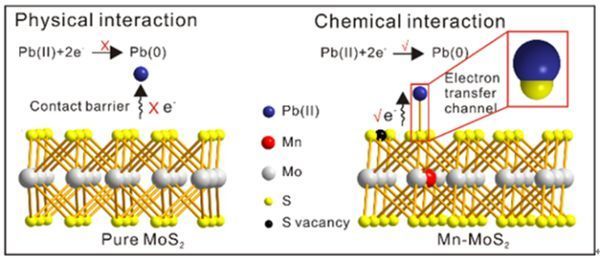
Researchers Reveal Ultrahigh Electrochemical Sensing of Heavy Metal Ions via Defect and Phase-Engineering
"In a paper published in Chemical Communications, the research group jointly led by Prof. HUANG Xingjiu from Institute of Intelligent Machines, Hefei Institutes of Physical Science prepared Mn-MoS2 Nanosheets for ultrasensitive electrochemical detection of heavy metal ions. The team found for the first time that chemical interactions between Pb(II) and actived S atoms in Mn-MoS2 facilitate the electron transfer and in situ catalytic redox reactions. Using nanomaterials to modify the electrochemical electrode is an effective method to improve the electrochemical-sensing performance. There is no doubt that adsorption capability plays a significant role in electrochemical detection. However, previous work mostly focused on enhancing the electrochemical-sensing performance via increasing the adsorption capability while ignoring the interaction mechanism between active sites and analyte. The mechanism remains unclear—particularly the difference in effect on electron transfer and catalysis between physical and chemical interactions, which limits the development of electrochemical sensing." [...]
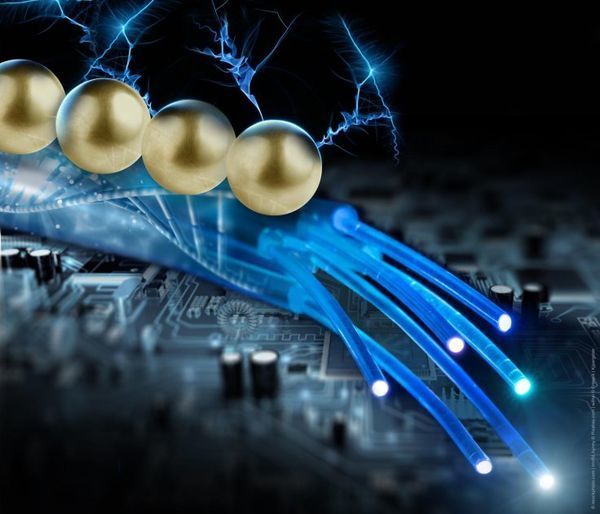
S&T researcher designs DNA-assembled electronic circuits for miniaturization of computers
"A researcher at Missouri S&T continues her exploration of self-assembled DNA nanostructures with a project to fabricate a new generation of molecular electronic circuits that would allow for the unprecedented miniaturization of computers and other electronic devices. Dr. Risheng Wang, assistant professor of chemistry at Missouri S&T, received a $350,000 grant from the National Science Foundation’s Division of Computing and Communications Foundation to discover predictable ways to fabricate metal electrode junctions for the integration of single molecules using DNA-based origami nanostructures as templates. Wang’s end goal is to use single molecules as the main building blocks for creating functional electronic circuitry. “With single molecules at the heart of their circuitry, computers and other electronics will be smaller and faster with greater storage efficiency and signal processing,” Wang says. “One of the holdups today in making molecular electronics is that there’s not a definitive way to construct a metal electrode junction with nanometer gaps that can be reliably reproduced.” “Microelectronics are reaching the limit of miniaturization through lithographic techniques that create circuits by transferring polymers, top-down, onto a substrate — like silicon,” Wang says. “To build these complex transistors, the transfer steps are repeated at least 10 times, but usually, 20 to 30 times.” The new, bottom-up methods that Wang will deploy would create metal electrode junctions using templates of synthetic DNA origami nanostructures." [...]
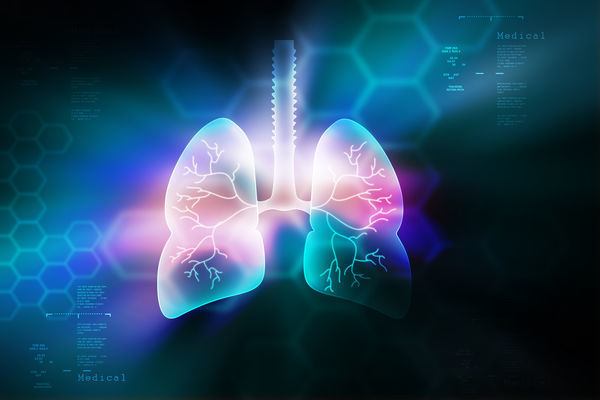
Biodegradable Graphene
"Degradation of pristine graphene occurs in the human body when interacting with a naturally occurring enzyme found in the lung, announced Graphene Flagship partners; the French National Centre for Scientific Research (CNRS), University of Strasbourg, Karolinska Institute and University of Castilla–La Mancha (UCLM). Graphene based products are being designed to be interfaced with the human body within the Graphene Flagship, including flexible biomedical electronic devices. If graphene is to be used for such biomedical applications, it should be biodegradable and thus be expelled from the body. To test how graphene behaves within the body, Alberto Bianco and his team at Graphene Flagship partner CNRS, conducted several tests looking at if and how graphene was broken down with the addition of a common human enzyme. The enzyme in question, myeloperoxidase (MPO), is a peroxide enzyme released by neutrophils, cells that are responsible for the elimination of any foreign bodies or bacteria that enter the body, found in the lungs. If a foreign body or bacteria is detected inside of the body, neutrophils surround it and secrete MPO, thereby destroying the threat." [...]

A new 'periodic table' for nanomaterials
"The table groups molecules according to the nano-shapes they form The approach was developed by Daniel Packwood of Kyoto University's Institute for Integrated Cell-Material Sciences (iCeMS) and Taro Hitosugi of the Tokyo Institute of Technology. It involves connecting the chemical properties of molecules with the nanostructures that form as a result of their interaction. A machine learning technique generates data that is then used to develop a diagram that categorizes different molecules according to the nano-sized shapes they form. This approach could help materials scientists identify the appropriate molecules to use in order to synthesize target nanomaterials. Fabricating nanomaterials using a bottom-up approach requires finding 'precursor molecules' that interact and align correctly with each other as they self-assemble. But it's been a major challenge knowing how precursor molecules will interact and what shapes they will form." [...]

The electronic transistor you've been waiting for
"How do you pack more power into an electric car? The answer may be electronic transistors made of gallium oxide, which could enable automakers to boost energy output while keeping vehicles lightweight and streamlined in design. A recent advancement — reported in the September issue of the journal IEEE Electron Device Letters — illustrates how this evolving technology could play a key role improving electric vehicles, solar power and other forms of renewable energy. “To advance these technologies, we need new electrical components with greater and more efficient power-handling capabilities,” says the study’s lead author Uttam Singisetti, PhD, associate professor of electrical engineering in UB’s School of Engineering and Applied Sciences. “Gallium oxide opens new possibilities that we cannot achieve with existing semiconductors.” The most widely used semiconducting material is silicon. For years, scientists have relied upon it to manipulate greater amounts of power in electronic devices." [...]
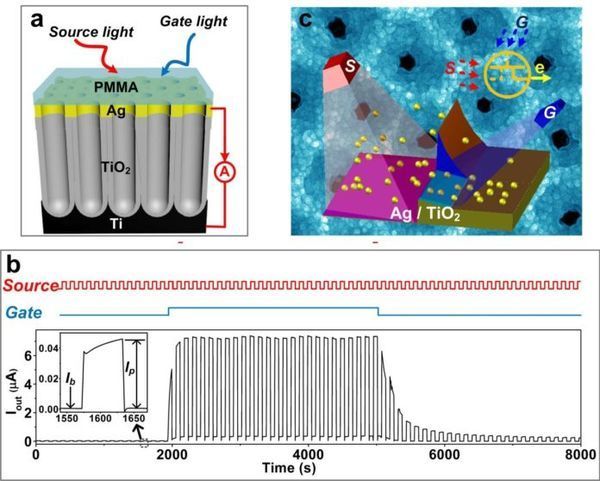
Scientists Make New Transistors Working Without Electricity Supporting
"Chinese researchers developed new transistors with all optical inputs which could work without electricity supporting making them applicable in some electricity forbidden environment. Transistors are the most important semiconductor components widely used in electronic equipment like computer, mobile phone and TV. The transistors have two electric inputs: gate and source. A feature of the transistors is that its output current can be tuned by the gate electric input. By replacing the gate electric input of transistor with a light input or by adding an extra light input, phototransistors have been developed that can tune the output current using light, which is widely used as light controlled switches in some devices. However, both for transistors and for phototransistors, the output currents all depend on the source electric input, the new type of transistors with all optical gate and source inputs have not been developed." [...]

Nanotubes change the shape of water
"Rice engineers show how water molecules square up in nanotubes Here’s one way to fit a square peg into a round hole. First, according to Rice University engineers, get a nanotube hole. Then insert water. If the nanotube is just the right width, the water molecules will align into a square rod. Rice materials scientist Rouzbeh Shahsavari and his team used molecular models to demonstrate their theory that weak van der Waals forces between the inner surface of the nanotube and the water molecules are strong enough to snap the oxygen and hydrogen atoms into place. Shahsavari referred to the contents as two-dimensional “ice,” because the molecules freeze regardless of the temperature." [...]
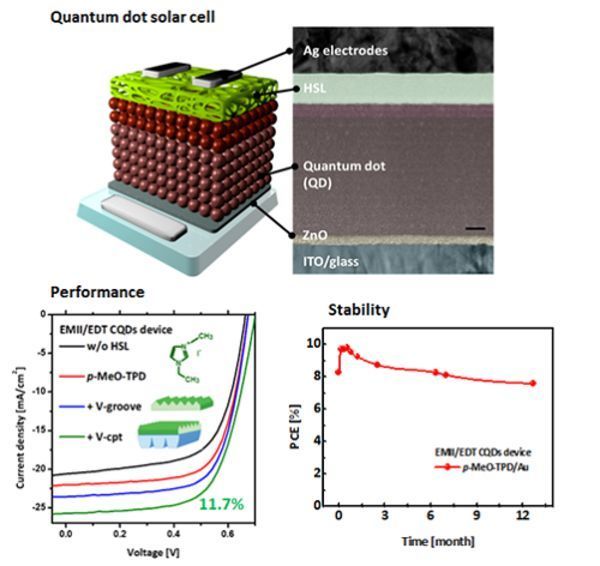
Improved Efficiency and Stability of CQD Solar Cells Using an Organic Thin Film
"Recently, the power conversion efficiency (PCE) of colloidal quantum dot (CQD)-based solar cells has been enhanced, paving the way for their commercialization in various fields; nevertheless, they are still a long way from being commercialized due to their efficiency not matching their stability. In this research, a KAIST team achieved highly stable and efficient CQD-based solar cells by using an amorphous organic layer to block oxygen and water permeation. CQD-based solar cells are light-weight, flexible, and they boost light harvesting by absorbing near-infrared lights. Especially, they draw special attention for their optical properties controlled efficiently by changing the quantum dot sizes. However, they are still incompatible with existing solar cells in terms of efficiency, stability, and cost. Therefore, there is great demand for a novel technology that can simultaneously improve both PCE and stability while using an inexpensive electrode material." [...]
Levitating 2D Semiconductor for Better Performance
"Atomically thin 2D semiconductors have been drawing attention for their superior physical properties over silicon semiconductors; nevertheless, they are not the most appealing materials due to their structural instability and costly manufacturing process. To shed some light on these limitations, a KAIST research team suspended a 2D semiconductor on a dome-shaped nanostructure to produce a highly efficient semiconductor at a low cost. 2D semiconducting materials have emerged as alternatives for silicon-based semiconductors because of their inherent flexibility, high transparency, and excellent carrier transport properties, which are the important characteristics for flexible electronics. Despite their outstanding physical and chemical properties, they are oversensitive to their environment due to their extremely thin nature. Hence, any irregularities in the supporting surface can affect the properties of 2D semiconductors and make it more difficult to produce reliable and well performing devices. In particular, it can result in serious degradation of charge-carrier mobility or light-emission yield." [...]
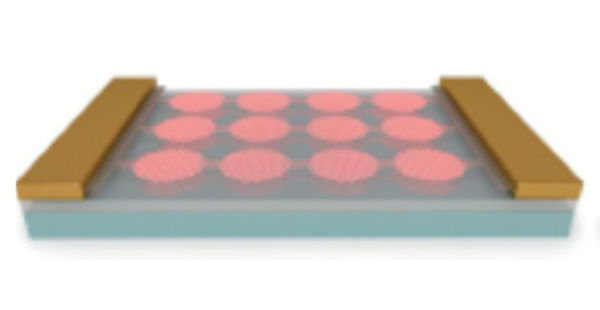
Graphene as an infrared detector
"An ICFO and Yale study uses graphene to efficiently detect mid-infrared light at room temperature and convert it into electricity. Detecting infrared light is of major importance for current applications in spectroscopy, materials processing, chemical, bio-molecular and environmental sensing, security and industry since the mid-infrared spectral region is the range where characteristic vibrational transitions and rotational excitations of many important molecules occur. These vibrational and rotational excitations of many molecules, including hazardous and biological molecules, have frequencies that lie precisely in the mid-infrared, which can be monitored by observing the absorption of light in this specific spectral range. However, currently available mid-infrared detectors are very inefficient, except those that can operate at cryogenic temperatures, because they incorporate superconducting elements. Thus, this low temperature limitation is a major drawback in having detectors integrated in devices for consumer products. Now, in a recent study published in Nature Materials, ICFO researcher Renwen Yu, led by ICREA Prof. at ICFO Javier García de Abajo, in collaboration with Prof. Fengnian Xia’s group Yale University, have demonstrated that graphene can be used to fabricate very efficient mid-infrared detectors operating at room temperature." [...]
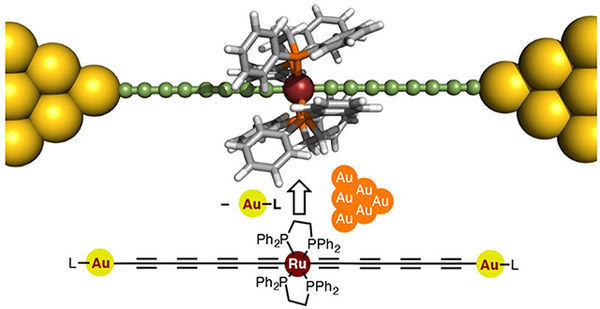
All wired up: New molecular wires for single-molecule electronic devices
"Scientists at Tokyo Institute of Technology designed a new type of molecular wire doped with organometallic ruthenium to achieve unprecedentedly higher conductance than earlier molecular wires. The origin of high conductance in these wires is fundamentally different from similar molecular devices and suggests a potential strategy for developing highly conducting "doped" molecular wires. Since their conception, researchers have tried to shrink electronic devices to unprecedented sizes, even to the point of fabricating them from a few molecules. Molecular wires are one of the building blocks of such minuscule contraptions, and many researchers have been developing strategies to synthesize highly conductive, stable wires from carefully designed molecules. A team of researchers from Tokyo Institute of Technology, including Yuya Tanaka and Munetaka Akita, designed a novel molecular wire in the form of a metal electrode-molecule-metal electrode (MMM) junction including a polyyne, an organic chain-like molecule, "doped" with a ruthenium-based unit Ru(dppe)2 (Figure 1). The proposed design, featured in the cover of the Journal of the American Chemical Societyouter, is based on engineering the energy levels of the conducting orbitals of the atoms of the wire, considering the characteristics of gold electrodes." [...]
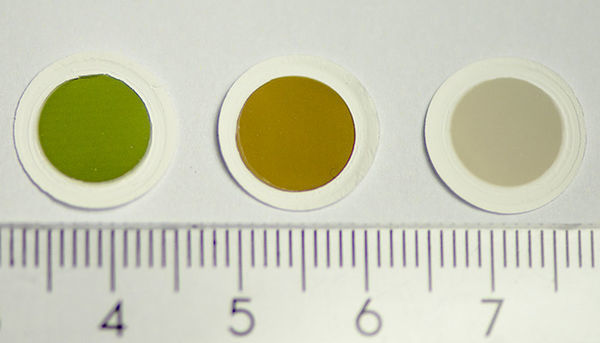
Carbon in colour: First-ever coloured thin films of nanotubes created
"Researchers present a technique to produce large quantities of pristine single-walled carbon nanotubes in select shades of the rainbow. The secret is a fine-tuned fabrication process—and a small dose of CO2. Single-walled carbon nanotubes, or sheets of one atom-thick layers of graphene rolled up into different sizes and shapes, have found many uses in electronics and new touch screen devices. By nature, carbon nanotubes are typically black or a dark grey. In their new study published in the Journal of the American Chemical Society (JACS), Aalto University researchers present a way to control the fabrication of carbon nanotube thin films so that they display a variety of different colours—for instance, green, brown, or a silvery grey. The researchers believe this is the first time that coloured carbon nanotubes have been produced by direct synthesis." [...]

A novel nanoactuator system has been developed
"Researchers at University of Jyväskylä (Finland) and University of Tampere (Finland) together with BioNavis Ltd (Finland) have developed a novel nanoactuator system, where conformation of biomolecule can be tuned by electric field and probed using optical properties of gold nanoparticle. Over the past decades, nanoactuators for detection or probing of different biomolecules have attracted vast interest for example in the fields of biomedical, food and environmental industry. To provide more versatile tools for active molecular control in nanometer scale, researchers at University of Jyväskylä and University of Tampere have devised a nanoactuator scheme, where gold nanoparticle (AuNP) tethered on a conducting surface is moved reversibly using electric fields, while monitoring its position optically via changes of its plasmon resonance. Forces induced by the AuNP motion on the molecule anchoring the nanoparticle, can be used to change and study its conformation. - Related studies use either organic or in-organic interfaces or materials as probes. Our idea was to fuse these two domains together to achieve the best from the both worlds, says postdoctoral researcher Kosti Tapio." [...]
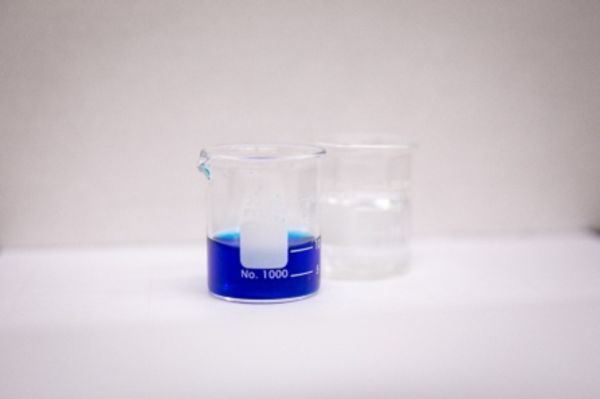
This bright blue dye is found in fabric. Could it also power batteries?
"Research shows that the chemical — a component of wastewater in textile-making — is good at tasks associated with energy storage A sapphire-colored dye called methylene blue is a common ingredient in wastewater from textile mills. But University at Buffalo scientists think it may be possible to give this industrial pollutant a second life. In a new study, they show that the dye, when dissolved in water, is good at storing and releasing energy on cue. This makes the compound a promising candidate material for redox flow batteries — large, rechargeable liquid-based batteries that could enable future wind farms and solar homes to stockpile electricity for calm or rainy days. The research appeared online on Aug. 13 in the journal ChemElectroChem. “Methylene blue is a widely used dye." [...]
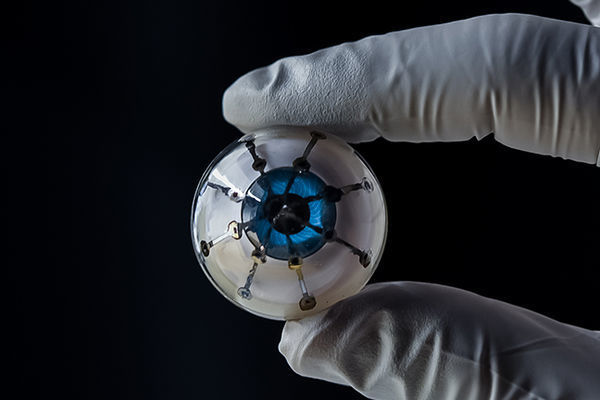
Research Brief: Researchers 3D print prototype for 'bionic eye'
"A team of researchers at the University of Minnesota have, for the first time, fully 3D printed an array of light receptors on a hemispherical surface. This discovery marks a significant step toward creating a “bionic eye” that could someday help blind people see or sighted people see better. The research is published today in Advanced Materials, a peer-reviewed scientific journal covering materials science. The author also holds the patent for 3D-printed semiconducting devices. “Bionic eyes are usually thought of as science fiction, but now we are closer than ever using a multimaterial 3D printer,” said Michael McAlpine, a co-author of the study and University of Minnesota Benjamin Mayhugh Associate Professor of Mechanical Engineering. Researchers started with a hemispherical glass dome to show how they could overcome the challenge of printing electronics on a curved surface." [...]
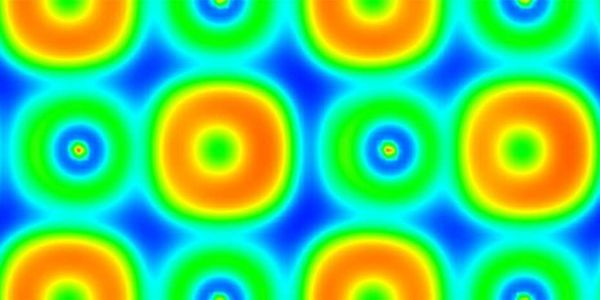
Uncovering atomic movements in crystal
"Scientists can spend a long time in heated debates over tiny details – for example, how and whether atoms in a crystal move when heated, thereby altering the symmetry. Using computer simulations for the mineral lead telluride on the CSCS supercomputer “Piz Daint”, ETH researchers have resolved a long-standing controversy. To outsiders, scientific questions can sometimes look like hair-splitting. These questions, however, are often crucial, as in materials science: the commercial use of a material stands or falls on its properties. One question that very much depends on such hair-splitting is the one that Boris Sangiorgio pursued in his doctoral thesis. In ETH Professor Nicola Spaldin’s research group at the Institute of Materials Theory, Sangiorgio used the supercomputer “Piz Daint” to examine how lead telluride (PbTe) behaves when it warms up." [...]
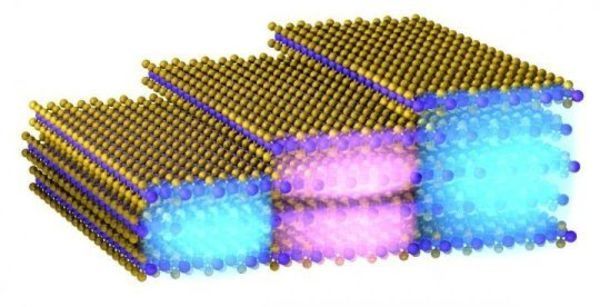
Nano-imaging of intersubband transitions in few-layer 2D materials
"A study in Nature Nanotechnology reports on the first observation of intersubband transitions in 2D materials via scattering scanning near-field optical microscopy. Semiconducting heterostructures have been key to the development of electronics and opto-electronics. Many applications in the infrared and terahertz frequency range exploit transitions, called intersubband transitions, between quantized states in semiconductor quantum wells. These intraband transitions exhibit very large oscillator strengths, close to unity. Their discovery in III-V semiconductor heterostructures depicted a huge impact within the condensed matter physics community and triggered the development of quantum well infrared photodetectors as well as quantum cascade lasers. Quantum wells of the highest quality are typically fabricated by molecular beam epitaxy (sequential growth of crystalline layers), which is a well-established technique." [...]
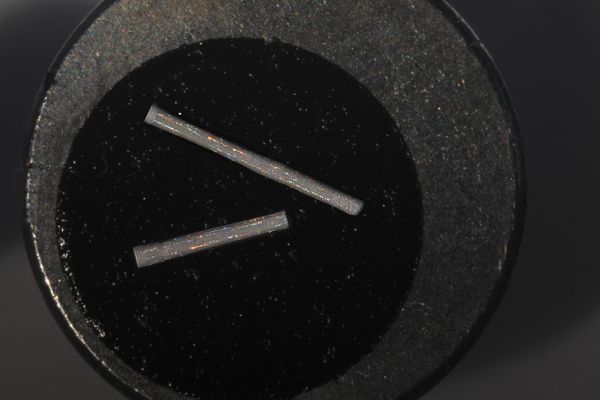
MIT researchers 3-D print colloidal crystals
"Technique could be used to scale-up self-assembled materials for use as optical sensors, color displays, and light-guided electronics. MIT engineers have united the principles of self-assembly and 3-D printing using a new technique, which they highlight today in the journal Advanced Materials. By their direct-write colloidal assembly process, the researchers can build centimeter-high crystals, each made from billions of individual colloids, defined as particles that are between 1 nanometer and 1 micrometer across. “If you blew up each particle to the size of a soccer ball, it would be like stacking a whole lot of soccer balls to make something as tall as a skyscraper,” says study co-author Alvin Tan, a graduate student in MIT’s Department of Materials Science and Engineering. “That’s what we’re doing at the nanoscale.” The researchers found a way to print colloids such as polymer nanoparticles in highly ordered arrangements, similar to the atomic structures in crystals. They printed various structures, such as tiny towers and helices, that interact with light in specific ways depending on the size of the individual particles within each structure." [...]

Device harvests energy from low-frequency vibrations
"A wearable energy-harvesting device could generate energy from the swing of an arm while walking or jogging, according to a team of researchers from Penn State's Materials Research Institute and the University of Utah. The device, about the size of a wristwatch, produces enough power to run a personal health monitoring system. "The devices we make using our optimized materials run somewhere between 5 and 50 times better than anything else that's been reported," said Susan Trolier-McKinstry, the Steward S. Flaschen Professor of Materials Science and Engineering and Electrical Engineering, Penn State. Energy-harvesting devices are in high demand to power the millions of devices that make up the internet of things. By providing continuous power to a rechargeable battery or supercapacitor, energy harvesters can reduce the labor cost of changing out batteries when they fail and keep dead batteries out of landfills. Certain crystals can produce an electric current when compressed or they can change shape when an electric charge is applied." [...]

Greener alternative to lithium-ion batteries
"The runaway popularity of personal electronic devices has led to a huge global demand for compact yet powerful rechargeable batteries. Since hitting the market in the 1990s, lithium-ion technology has taken the lead in meeting this need. But concerns over the relative scarcity of lithium and the toxicity of other common lithium-ion battery ingredients such as cobalt are driving the search for an alternative. Sodium, around 1000 times more abundant than lithium, could be the answer. McGill University chemistry professor Eric McCalla is aiming to push the sodium-ion battery from concept to a commercial reality that will perform comparably to lithium-ion batteries but be less expensive to make and have a smaller environmental footprint. “Trying to displace lithium-ion you have to be noticeably cheaper and your processing has to be almost identical,” McCalla says." [...]
Documentação
A documentação é parte essencial do processo de aprendizagem e a Internet além de artigos interessantes de explorar também tem alguma documentação em formato PDF interessante de ler. Todos os links aqui apresentados são para conteúdo disponibilizado livremente pelo editor do livro.

The MagPI 73
"If you like to program, you probably have aspirations of making your own video game. In this issue we break down the barriers to entry and show you how to get started. We also show you how to secure your home with a Raspberry Pi, along with our usual selection of excellent projects, tutorials, and reviews. All this inside The MagPi 73 - Learn to code with BBC TV - AIY Edge TPU Accelerator from Google revealed - Racing your own robots with Formula Pi - Build a dinner klaxon for busy people - Top 10 Raspberry Pi robot kits - And much more! Need more details? View the contents pages for info on every article." [...]
Projetos Maker
Diversos Projetos interessantes.
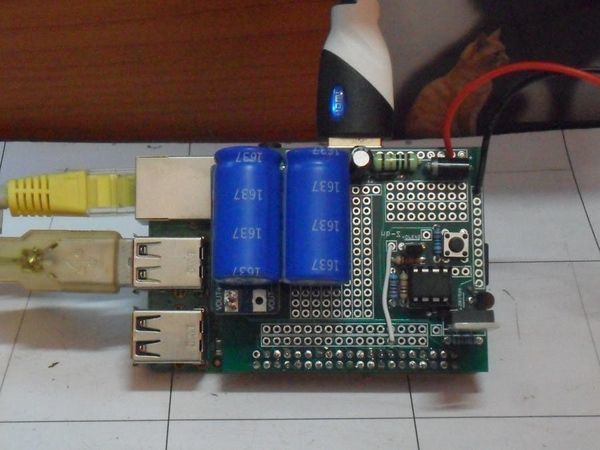
Safe Shutdown and Auto Bootup for Raspberry Pi
"Have someone pulling the plug on your project, or perhaps an unstable or unreliable power supply? Here is the fix! Introduction Whether it's a media center, file server, web server, robot, car PC, or an arcade console, a battery-less UPS for the Raspberry Pi gives it enough juice to shutdown properly and then boot back up when sufficient power is restored. I've had one to many times have the power "fail" on my Pis. Many times it is a human "fail" by inadvertently pulling the plug. Now I don't need to worry about that anymore." [...]

Use Capacitors to Measure Temperature
"This project came about because I bought a capacitor kit with mainly X7R (good quality) capacitors, but some of the higher values 100nF and above were the cheaper and less stable Y5V dielectric, which exhibit a massive change over temperature and operating voltage. I wouldnt normally use Y5V in a product Im designing, so I tried to find alternative uses for them rather than let them sit on the shelf forever. I wanted to see if the temperature change could be exploited to make a useful and very low cost sensor, and as you'll see over the next few pages it was quite simple, with only one other component required. " [...]

DIY Turntable
"Stationary showpieces? Too mainstream!Stationary art? Where's the fun in that! How about adding some movement? Behold the terrific turntable, a rotating instrument that is both fascinating and useful at the same time! You can use it to make cool patterns, paint objects, and even display different showpieces." [...]

DIY Bluetooth Temperature Sensor (ATTINY85)
"I wanted to build a bluetooth temperature sensor which I could use to read remotely the temperature in my green house. I decided that the first step would be to build a prototype on a breadboard. This project describes the construction and operation of the prototype, i.e. how a remote temperature reading may be viewed on an Android Phone or laptop. Temperature is read from a low cost temperature sensor using a small but powerful microprocessor - ATTINY85 - and transmitted to a PC or Android Phone using a HC-06 bluetooth sensor. The basic principle is that a serial connection is set up between the ATTINY85 chip and the user device via a bluetooth chip (HC-06)." [...]

Electronoobs Watch - Internal 8mhz Clock
"This is another very simple project and kind of geeky. I’ve made my own digital watch. If you think there is nothing to learn with this simple project, well, you’re wrong. We will learn how to use the ATmega328p - AU chip without an external clock by burning an 8MHz internal clock bootloader. The chip will work at low voltage, 3.2 volts from a button cell battery. The battery has low capacity, so, we need a low consumption." [...]
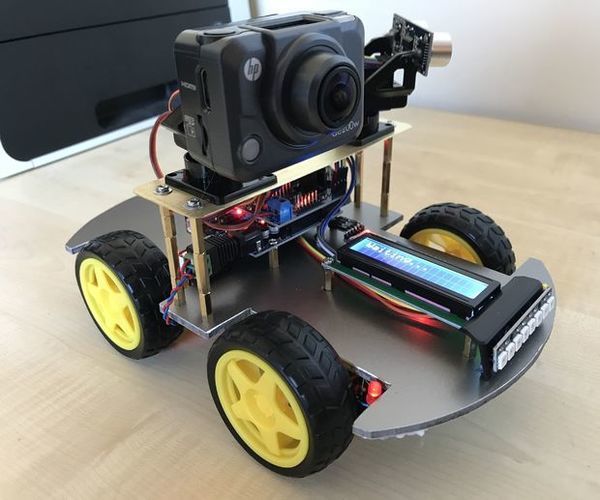
Bluetooth Robot
"ARDUINO BLUETOOTH ROBOT CAR Project Date: August 2018 Project Equipment: 1. 1 * Custom base platform. 2. 4 * DC Motor + Wheels. 3. 3 * 18650 batteries with 3 battery holder and 2 *18650 batteries with 2 battery holder." [...]

DIY Adjustable Constant Load (Current & Power)
"In this project I will show you how I combined an Arduino Nano, a current sensor, an LCD, a rotary encoder and a couple of other complementary components in order to create an adjustable constant load. It features a constant current and power mode and can handle a maximum of 30V and 20A if your heatsink design can handle it. Let's get started! " [...]

Arduino Uno/Leonardo Keyboard Macro Box
"The parts you need to make the keyboard macro box are: Electronics: Arduino Uno or an Arduino Leonardo https://store.arduino.cc/arduino-uno-rev3 Momentary push buttons (I used 15 in my design) https://www.ebay.co.uk/itm/16mm-Round-Metal-Push-B... Jumper Wires, one for each button, power and ground pins. https://www.ebay.co.uk/itm/40-pcs-Dupont-Cables-M-... A Resistor (I used a Red, Red, Brown also known as a 220 ohm resistor) Strip board/Breadboard Soldering iron and solder. Optional Electronics: LED (External box power LED) A Resistor (I used a 180 ohm resistor) Housing Box: 6mm MDF (minimum 32cm x 24cm) Handsaw/Jigsaw for cutting the pieces. Wood Glue. Varnish and a brush. (I used antique pine and gave my box two coats." [...]

Alcohol Unit Counter
"There seems to be a lot of discussion in the news currently about how much alcohol it's safe to drink on a regular basis [1][2]. If you want help in monitoring your alcohol consumption this gadget might be useful. You enter the number of units you drink each day, and it keeps track of where you are relative to your target intake: It's based on a low-cost two-digit LED display and an ATtiny84. Introduction I built this circuit a while ago when I wanted a way to keep an eye on my alcohol intake. Of course you could achieve the same result with a calendar and notebook, but this is more fun and motivating. The aim is to keep to a sensible average level of consumption, with the ability to enjoy several drinks when the occasion arises." [...]

LED Strip Atari Pong Arcade Machine
"My name is Gabriel Podevin and this is my very first intructable. I am currently a 16 year old high school student who loves creating and building things while being very interested electronics, robotics, circuitry, and programming. I hope you can find this intructable find this helpful. In this instructable I will be showing you how to make a retro styled Atari Pong Game inside a retro arcade case. You can see the above video for a demo of the project, you can also see the finished project and the case alone and in the two pictures. At the end of this intructable i will be diving deeper into the code and how to edit it to personalize it." [...]

Arduino Nano as CP/M-Compatible Computer
"I will begin here with a description of my project cpm4nano - a CP/M-compatible computer based on the Arduino Nano 3.0. Currently one (!) Arduino Nano (!) in my project: emulates the i8080 processor, 64 KBytes RAM+additional banks, 4 FDD; loads the OS CP/M and runs its programs; exchanges information with PC on the serial port, including uploading files to the emulator using the XMODEM protocol; with the help of the converter PS/2-UART allows you to enter information from the keyboard; displays text information on the TV screen (20 rows with 40 cols) (without jitter!). " [...]

Nixie Clock / Display / Full Build
"It has been more than a year since I posted an instructable. I finished high school, got into college to study Electrical Engineering and now with my first year completed and much deserved holidays, I will write a few instructables from projects that I have been making over the year. I know that Nixie clocks are overdone and projects making them are being covered to death. But with that in mind, I searched for kits, pcbs and anything to assemble one as when I found out about Nixie tubes, I ordered some. I had to make a power supply to make them work, so as impatient as I am, I couldnt order a kit from china. Then I needed to make the drivers for each Nixie and sooner or later I decided upon making a clock from scratch." [...]

Home Manager
"Control your home, your robot arm, your Dalek, do some gaming, have a simple sport helper and an elderly safety guard in a versatile device! Introduction In the past I made a couple of projects that worked great, but could have more use with a remote controller. I could have used just my phone as a remote controller, but as an experiment I built a cool and expandable device to do just that. The project will cover how I built the hardware and what you'll need to do to reproduce it. I'll also explain how the software works and what functions it does have at the moment. Goals Originally I planned on controlling just some of my devices at home: the magnetic hidden door lock, the LED lights above the kitchen sink, the irrigation system of my mimosa plant, and maybe remotely controlling my robot arm." [...]
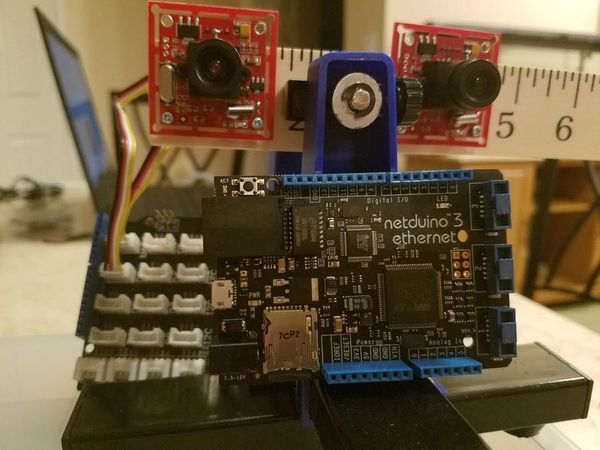
Stereo Vision on Netduino
"Managing two cameras to calculate a depth map using a Netduino board and C#. Stereo vision has been one of the most complicated and resource intense process's to extract 3D information. The Netduino 3 Ethernet board, equipped with a Cortex-M4 168 Mhz microprocessor, is capable of intense execution for small amounts of image data. The board also comes with 4 UART ports ready for use and is perfect for serial communication cameras. We were able to support the OV528 protocol to communicate with two serial cameras and acquire two continuous photos of still objects. In the near future we will apply one of the stereo vision algorithms to extract the 3D information out of the acquired images." [...]
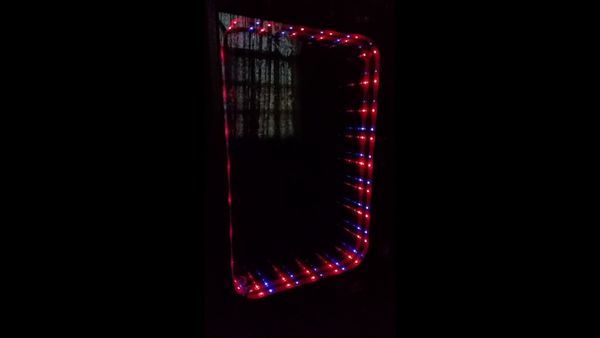
RGB Infinity Mirror with 3D Magnetic Sensor
"An infinity mirror with an RGB LED strip that can change its color using Infineon's 3D magnetic sensor knob connected to an Arduino MKR1000. When I saw the infinity mirror effect for the first time, I was impressed with it. I wanted to build my own version of it, and so, I decided to use Infineon's 3D magnetic sensor kit with the rotator knob to control colors on an infinity mirror with an RGB LED strip. " [...]
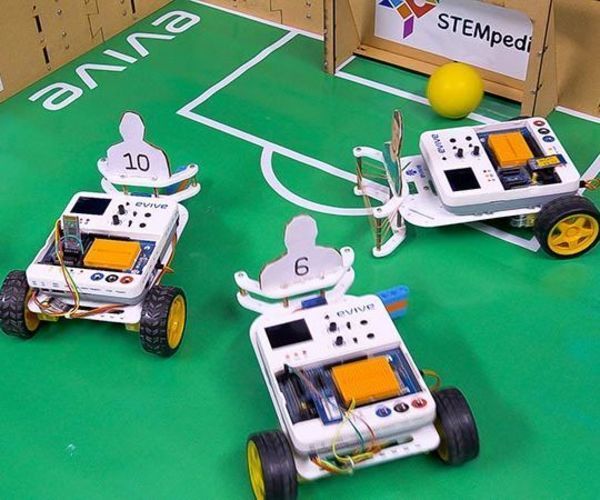
DIY Soccer Playing Mobile Robot
"Playing soccer is fun, but playing soccer with robots is awesome. In this project, we are going to build DIY soccer playing robots which will be controlled using Smartphone Gamepad App. It feels like you are playing on a PlayStation using the app, but you are controlling robots and scoring the goals. We have made 4 robots: 2 Strikers: Who has an extra leg type link, which helps them to attack. 2 Goalkeepers: Who has rubber bands on the front to save the goal. The Arena is similar to a football ground." [...]
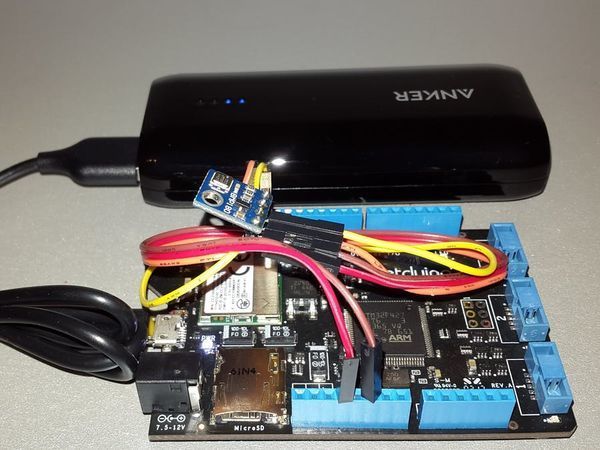
Battery Powered Weather & Air Quality Monitoring Station
"A web-enabled weather station implemented with Netduino 3 WiFi and a BMP180 sensor. Preparations To get familiar with the Netduino 3 WiFicand create a Visual Studio 2015 project, we can follow the instructions from the Netduino's official Getting Started guide. We also want to set up the network settings as described in the Network guide. " [...]
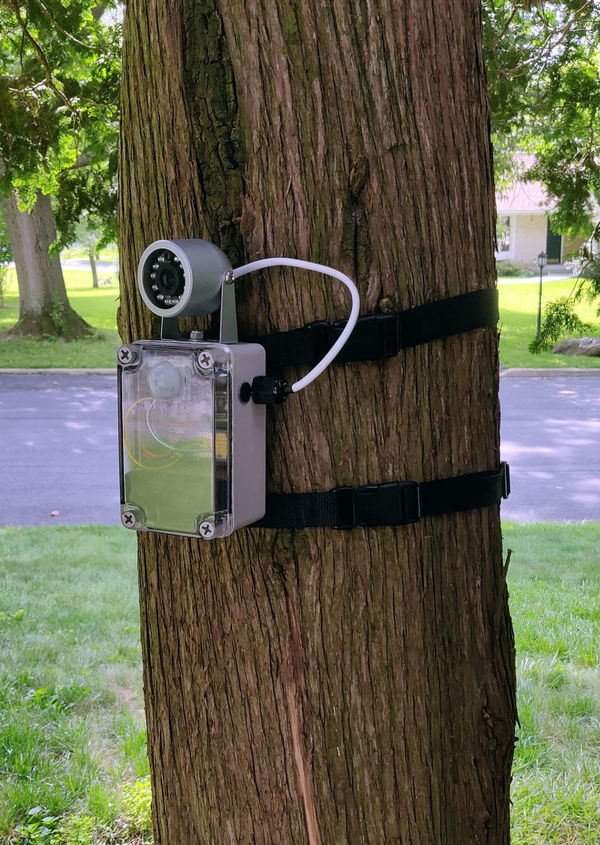
MammalCam
"Motion Activated WiFi Camera Made with the Adafruit Feather M0 This is a firmware application written in C++ using Arduino and Adafruit libraries. It sleeps in low power mode until, activated by the motion sensor, it takes a picture. Images are posted to io.adafruit.com using the REST API. Motivation I've long wanted to play with an automatic wildlife camera just for the fun of it. We have lots of deer in our neighborhood and this camera is intended to take pictures of them eating my wife's garden. There's also the fact that this project uses a TTL serial camera that speaks the VC0706 protocol." [...]
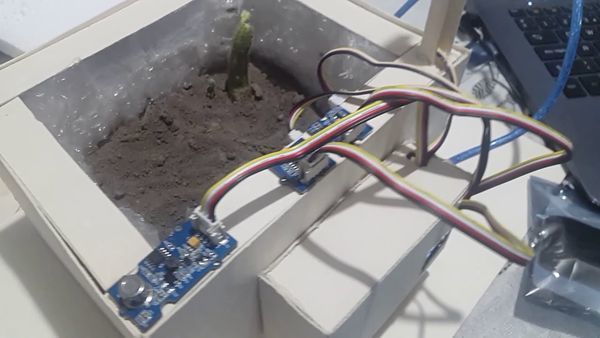
Monitoring System for Smart Crops
"Design and build a system to monitor the status of your crops using the Netduino 3 WiFi. In Colombia, and the world at large, there is an urgent need to obtain renewable energy resources as ecosystems due to climate change have been affected. Here is a clear example of the events that can occur due to a lack of renewable alternatives: During the Cesar Gaviria governmental administration (1992), Colombia suffered energy rationing as the result of a drought. The reservoirs used for the generation of electricity depleted; the phenomenon affected us and left us in a position that, although it was believed that the system was prepared to support it, still the generation of energy was very affected. The constant cuts of the energy supply had affected productive sectors (commercial, industrial), educational and home. In some homes, performance is very restricted (lighting, ventilation, cooling) due to the lack of this fluid, affecting its inhabitants." [...]
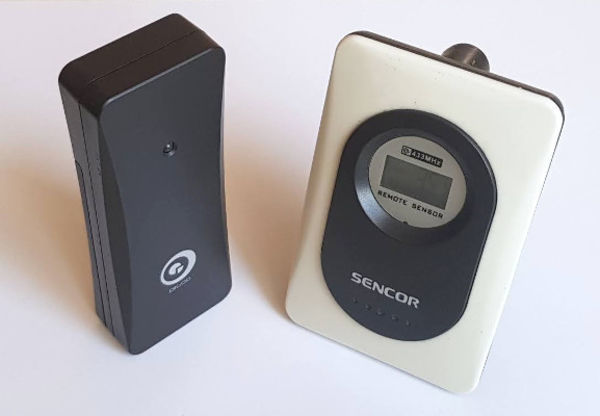
nexus433
"433MHz temperature and humidity sensor receiver that integrates with home automation systems. Introduction This program can read data from cheap 433 MHz wireless temperature and humidity sensors and integrate with home automation systems using MQTT broker. It was designed to work with popular ARM boards like Raspberry Pi, Orange Pi and many others. Home Assistant MQTT sensor discovery is available. To make it working you need only one external component – 433 MHz receiver. It have to be connected to one of the I/O pin, the program can decode directly data from sensors without any third party additional components." [...]
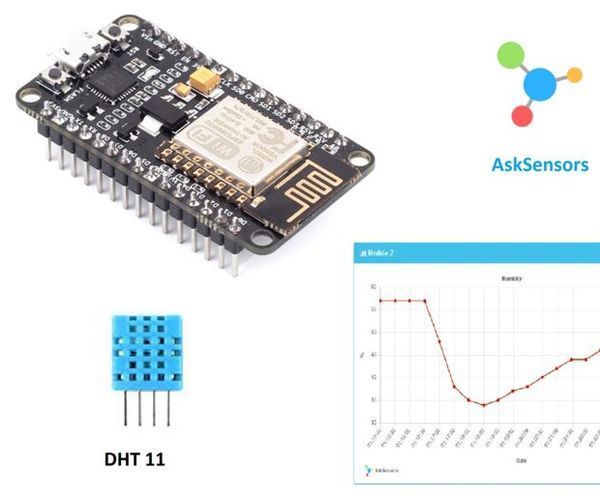
DHT11 Temperature and Humidity Monitoring Using the ESP8266 and the AskSensors IoT Platform
"In a previous instructable, I presented a step by step guide to get started with the ESP8266 nodeMCU and the AskSensors IoT platform. In this tutorial, I'm connecting a DHT11 sensor to the node MCU. The DHT11 is a commonly used Temperature and humidity sensor for prototypes monitoring the ambient temperature and humidity of a given area. The sensor can measure temperature from 0C to 50C and humidity from 20% to 90% with an accuracy of 1C and 1%. DHT11 Specifications: - Operating Voltage: 3.5V to 5.5V - Operating current: 0.3mA (measuring) 60uA (standby) - Output: Serial data - Temperature Range: 0°C to 50°C - Humidity Range: 20% to 90% - Resolution: Temperature and Humidity both are 16-bitAccuracy: ±1°C and ±1%" [...]
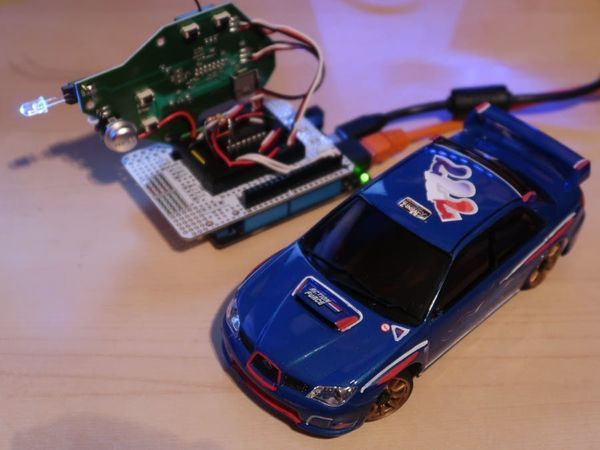
IoRCT: The Internet of Radio-Controlled Things!
"Drive a radio-controlled car via a RESTful API using any internet-enabled client! As a long-time .Net and Visual Studio fan, I was immensely excited when I discovered the original Netduino - finally I could use the same IDE I develop software with all day long for my hardware projects! I somehow got distracted with a million other boards along the way, but this contest allowed me to rekindle my love for the .Net Micro Framework - this time re-imagining a project I'd created back on the original device which allowed me to control a radio control car via a PC - but now with added IoT goodness thanks to the networking capabilities of the Netduino 3 Ethernet! 🎮🏎️ Development Process The first step in my project was tearing down the KT-18 controller from my Mini-Z in order to replace the potentiometers that are used in the steering wheel and throttle trigger with a DS1803 Addressable Dual Digital Potentiometer, allowing me to emulate their positions digitally. I connected the DS1803 to the Netduino's SDA and SCL pins in order to communicate with it via I2C. I then refactored to create a DS1803 object for better abstraction from my main Program.cs." [...]
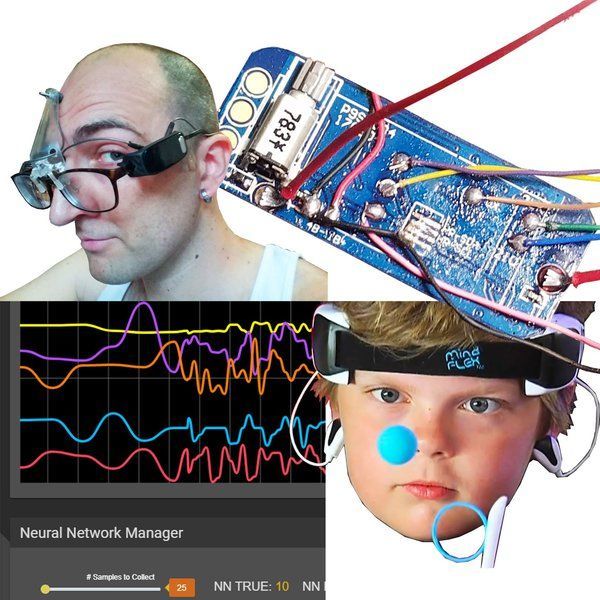
Hacking a $35 ECG nRF52 Fitness Tracker into EEG
"nRF52832 ECG fitness tracker hacked into EEG glasses using Arduino code + detect concentration/relaxation with neural network web app The B20 Fitness Tracker contains an ADS1292 bioimpedance sensor which can be used for simple ECG, EMG and EEG sensing. It also contains a nRF52832 ARM Cortex M4 processor which can easily be programmed with Arduino. With Bluetooth, OLED display, accelerometer, optical HR sensor and vibration motor - all for $35 in a miniaturized form factor - it is a pretty extraordinary prototyping platform for simple ECG/EMG/EEG projects. A few months ago I ran a workshop on hacking the Neurosky/Mattel Mindflex EEG headset. Despite being a super famous hack, the core "concentration" detection feature is still a black box after all these years! I decided to replicate this functionality with the B20." [...]
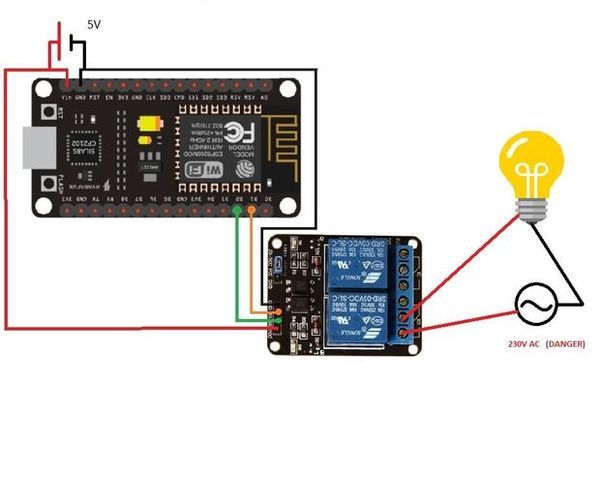
DIY Voice/Internet Controlled Home Automation and Monitoring Using ESP8266 and Google Home Mini
"After all the HOME AUTOMATION articles I have written from BLUETOOTH, IR, Local WIFI, Cloud i.e. the difficult ones, *NOW* comes the easiest but the most efficient HOME AUTOMATION solution. T his project needs less hardware, circuit unlike my previous projects. The utilization of services from different software companies is mostly seen in this with a little bit of Arduino and circuitry knowledge. Let's not bore you. Enjoy LAZINESS!!!" [...]
That's all Folks!


